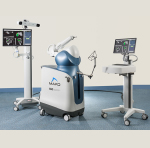
Joint replacement operations have an excellent success rate helping patients who were previously crippled by painful, stiff, arthritic joints be able to walk again. During the operation the surgeon cuts and prepares the bone then places the new prosthesis as accurately as possible in position using a series of jigs, saws and other instruments. Our aim is always to be as accurate as possible but most studies show some variability in how well we achieve this./p>
Our attempts at accuracy are now helped by the availability of a surgical robots that helps with the planning and execution of the operation.
There are different types of robots supported by different prosthesis/implant companies. They all have their advantages and disadvantages. With some robotic systems the patient will have a CT scan prior to surgery. With others they will not.

 Locations
Locations









